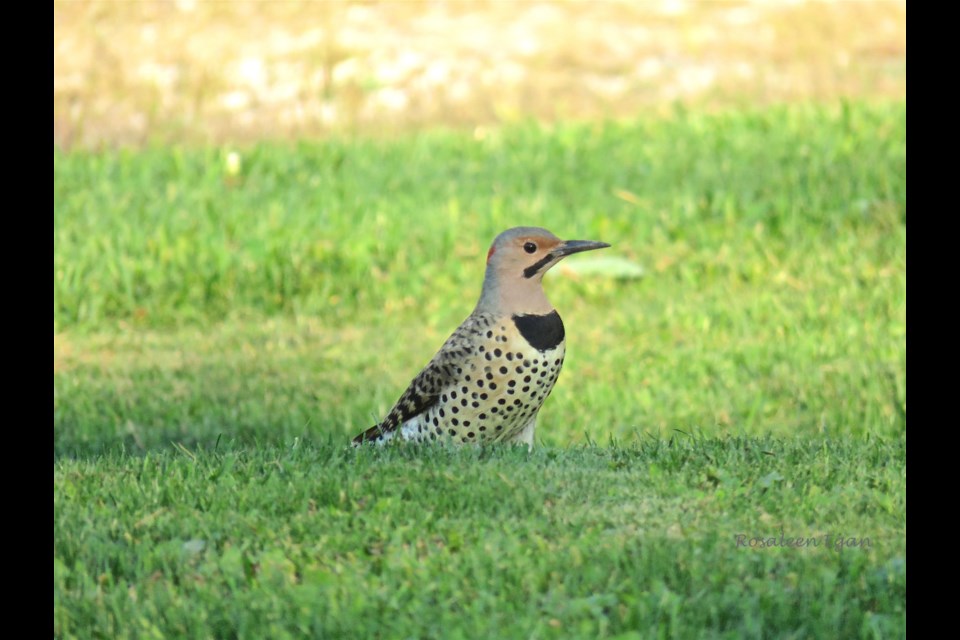This is a northern flicker. It is a decidedly handsome bird, and a large woodpecker.
Unlike most woodpeckers, a northern flicker spends a lot of time eating bugs from the ground. I was happy to see one doing just this thing the other day on my lawn.
It is also uncharacteristic of a woodpecker in that it sits upright on branches, rather than along the bark of a tree. It can climb a tree and hammer on it just like other woodpeckers. Flickers also fly in the undulating manner of most woodpeckers, interspersing periods of gliding and flapping.
A few years ago, when I was reading about northern flickers on allaboutbirds.org, the site gave me the solution to a persistent conundrum. It said, “Look for the obvious white rump patch in flight.” This little sentence solved a big mystery for me. It flicked a light on.
Driving back home from Algonquin Park one summer, I spotted birds eating at the side of the road and showing a white rump while flying the short distance into neighbouring trees as the car approached. I couldn’t make out what I had seen from a distance then, or other times when I saw the same distant thing. I tried a few times to identify the bird by searching “brown bird with white rump” and came up empty. Then, I just stumbled upon the ID information.
I was previously familiar with northern flickers, but not familiar enough to know about the white rump, so I hadn’t put it together. The website info does say it can appear overall brown. It made sense with the size and shape of the bird that what I had been seeing from a different perspective was a bird I knew in closer proximity. Sometimes, I could see the cravat, but I wasn’t close enough to see the other details.
I was very happy to have an answer presented to me. As the bird knows, if you dig around long enough, you’ll find what you’re looking for. It is mainly looking for ants and beetles. It also eats fruits and berries of native plants, especially in fall and winter. At times, it will eat seeds and nuts.
The northern flicker (yellow-shafted) is far from an overall brown bird, of course. Both males and females have subtle buff undertones with a sporty spotted breast, black bib and yellow shafts on the flight and tail feathers. The male’s black whiskers match the bib or, to suit the elegance, a cravat. And everyone’s got to love a bird that wears a red heart on its head.
It has a western counterpart, the northern flicker (red-shafted), of which the male has red whiskers instead of black, and red shafts.
According to Audubon.com: “Northern yellow-shafted flickers from Alaska and Canada (are) strongly migratory, most travelling east and then south. Big flights move down (the) Atlantic coast in fall, migrating by day.”
Birdsoftheworld.org says, “Peak spring migration occurs from late March to early April, with most birds reaching breeding grounds by April 7. Peak fall migration occurs from late September to early October, with some migration continuing to early November.”
Northern flickers have a clutch of five to eight eggs and nest in holes in dead or diseased wood, sometimes reusing a cavity year to year. Although I don’t know where they may be nesting, I have seen young birds here.
I find mid-summer to be a quiet bird time as some species moult and retreat for safety while new feathers grow in. This made me particularly happy to see the northern flicker this week. I sure hope it hangs around for a while before going south.
I share experiences of bird visitors to this property with readers every couple of weeks. Until next time, keep your eye to the sky, and look for birds that may come by.
Rosaleen Egan is a freelance journalist, a storyteller, and a playwright. She blogs on her website, rosiewrites.com.



